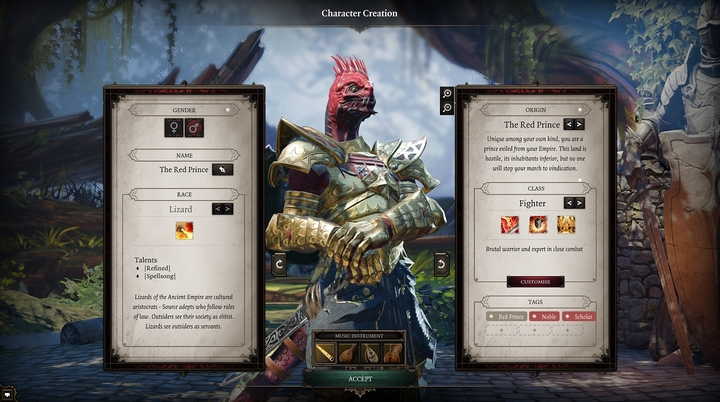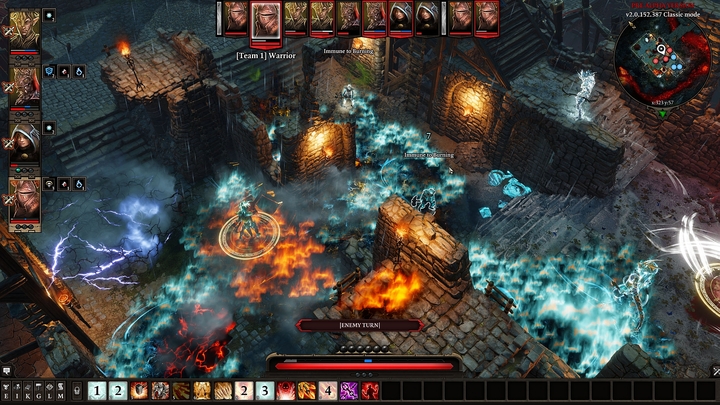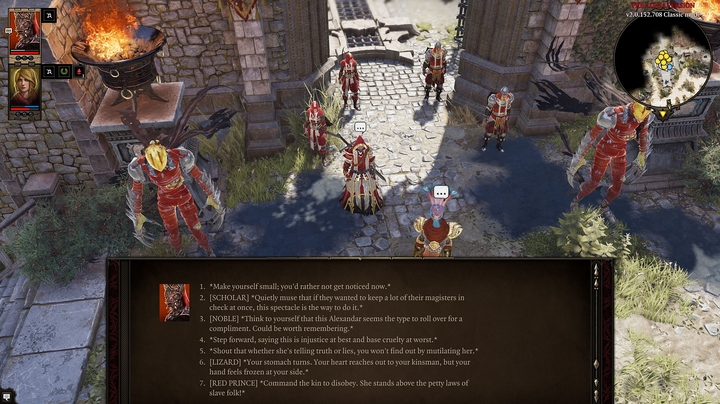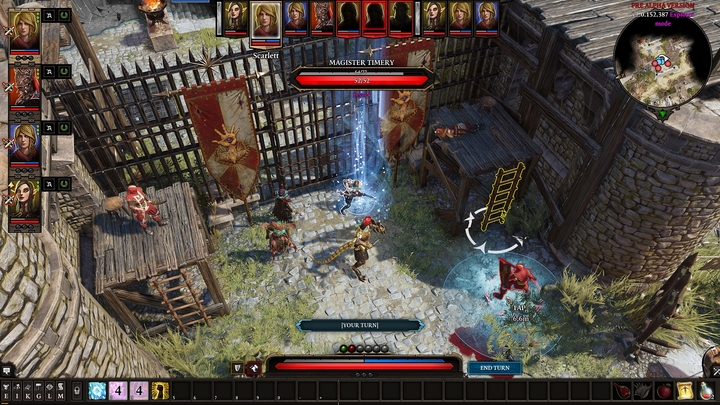Divinity: Original Sin II hands-on – what’s new in the sequel of one of the best recent RPGs?
Larian Studio has reminded the world about Divinity: Original Sin II by bringing the game to gamescom 2016. A half-hour presentation was enough to convince us that this could be the dark horse among 2017’s RPGs.
If you asked someone what’s the hottest old-school RPG currently in development, you would probably hear names like Torment: Tides of Numenera by inXile Entertainment, or Tyranny by Obsidian. Due to the avalanche of information published about these games in recent moths, it wasn’t hard to forget that there’s one more that’s going to bring something into the world of classic cRPGs – it’s Divinity: Original Sin II by Larian Studios. About a year ago we were all impressed with the enormous success of the game’s Kickstarter campaign (the devs asked for USD 500,000 and received four times the amount), but then, the game went quiet… until now. Divinity: Original Sin II has been shown during gamescom 2016. After watching the new game set in the world of Rivellon for half an hour, all we can say is: Torment, beware!

One can be more than two
The showcase started with the basics, i.e. the creation of our character. Note the singular, not plural, as this time around we have only one protagonist. This doesn’t mean that the whole process takes half the time it took in the previous game – there are a lot of new options available. Apart from the typical elements, such as sex, class, skills, talents, attributes, and so on, we will, first and foremost, choose the race of our hero. We can chose either human, dwarf, elf, or lizardman. In time, there will be one more race available – the undead, which was one of additional goals of the Kickstarter campaign. Needless to say, the choice will not be purely cosmetic; each race has an individual set of skills, and will be differently perceived by NPCs. The latter fact is noteworthy, because, as Larian studio emphasize on every occasion, dynamic relations between the players and the game world are very important for them.

Those relations will be influenced, perhaps the most, by the origin story that we can choose for our hero from a set of 8 to 10. What is actually meant by this term is that the characters are predefined, and can only be slightly modified. The players aren’t obliged to choose any of the available origin stories, but if they decide to do so, they will receive a character with a unique storyline, which will intertwine with the main plot during the whole game, and influence the shape of the adventure in numerous ways (for example by unlocking unique dialogue options). This is especially important in the multiplayer (where four people can play in one game), as the players can have mutually exclusive agendas. That’s why he multiplayer in Divinity: Original Sin II shouldn’t really be called a co-op; after all, the players might just as well stand against each other. What’s even cooler is the fact that solo players will be able to get a taste of this mechanic as well. All the origin stories that the player doesn’t choose will be used by the game to create NPCs that we’ll encounter during the campaign, and who can become AI-controlled party members. And they won’t be just standing there and waiting for our attention for ever – should the player decide not to include them in his or her team, they will venture into the world by themselves, and appear from time to time in different places, at different stages of the story, showing different attitudes towards our hero.

Fortunately, all this doesn’t mean that you must choose a predefined character in order to have fun in the game. The bonuses, such as unique dialogue options, are also provided by so-called tags – those are traits that define factors such as origin, personality, or the place in society (nobleman, sage, outcast, and trickster). At the beginning they are determined by the choice of class, sex, origin story, etc., but later on, subsequent tags can be added or lost – for example by making certain choices in dialogues or during quests. The bottom line: if all this really works, the fans of role-playing are in for quite a treat.
To sum up the subject of characters, let’s take a closer look at a really cool tidbit – Larian Studios has developed something they call an “adaptive music system”. Thanks to this, each protagonist will have their own theme, played, for instance, when a spectacular critical hit is dealt, or the plot takes an especially important turn. It’s seemingly just a little something, but looks really fun, especially in the multiplayer mode.

Good old hardcore
After getting through the process of creating our character, the developers went for the gameplay itself, and showed us the very beginning of the game. Just as in the first Original Sin, everything begins on a beach, but this time, the circumstances are completely different – while previously we’ve hunted the bearers of the destructive power of the Source, this time we’ll become one of them. Besides, the stories of both games are separated by a thousand years; here, the plot unfolds during dark times where the Divine is dead, and the world is under attack by horrific creatures from the Void (some years after Beyond Divinity). In this world, the Divine Order fights to avert the crisis by eliminating everyone who knows how to control the power of the Source – they are sent to a prison island, a place called Fort Joy, where their power is taken away. We meet the protagonist when they are on their way to meet such a fate themselves, but their ship is sunk by the monsters from the Void. The players then find themselves on said beach, and have to look for a way out from Fort Joy… and under the Order’s skin, while simultaneously saving the world.
Players will be able to see for themselves how hard it is to control the power of the Source. On September 15, Divinity: Original Sin II will become available in Early Access. The devs will let the players try out the first 8–10 hours of the game – the escape from Fort Joy. It may not seem like much, but even the early build of this game should provide a nice dose of replayability, since it will offer four different origin stories (more should be added later).

As for the gameplay mechanics, the general idea remains identical as in Divinity: Original Sin. This is still an RPG with isometric perspective (although the camera can rotate and zoom), which offers a lot of freedom in manipulating the environment and a high level of difficulty – both during the turn-based combat as well as in the case of environmental puzzles. “I’m going to show the game in Classic Mode, because if I chose Hardcore Mode, you would only watch me load the game again and again”, said one of the developers before the showcase; these words ought to give you an idea of what this game is. This doesn’t mean, however, that Larian didn’t lift a finger to make the game a little bit more accessible to less experienced users. A more user-friendly interface was added, along with a clearer location design. The number of action points has also been reduced to make it easier to strategize during combat (subsequent actions will cost no more than three points).

There are plenty new features that the veterans will appreciate. The tactical layer has been deepened with a height factor – going up a ladder (another novelty) and getting you character onto a tower will increase their range and the power of ranged attacks, as well as make them harder to hit. The tactical depth is further improved by a plethora of previously unavailable curses and blessings, such as Bloody Rain, which causes bleeding to enemies within the given area. Using Contamination after Bloody Rain on the same area will produce a very dangerous acid. An icing on the cake is provided by the mighty powers of the Source. The crafting system has also been overhauled.
Larian Studio definitely pays a lot attention to the combat system. There will also be a totally new multiplayer game mode – a pure PvP arena. Four-player groups will be able to compete on cleverly designed battlefields, fighting in iterations of classic modes such as Free-For-All, Capture the Flag, or King of the Hill. The players will use predetermined characters, and matches will last as long as 20 minutes.

We also have to mention the graphics (generated by Divinity Engine 3.0). Visually, the game is a whole lot better than the previous part. The textures are sharp, and water effects eye-catching. Physics are also pretty realistic.
There is some innovation in terms of the plot, too. Most of all, the number of possible interactions has been increased. For example, players will be able to talk with spirits, and elves will gather knowledge by... consuming other characters’ limbs. Talking with animals, known from Divinity: Original Sin, will also be there. Probably nothing will stop the players from killing every encountered NPC if they wish to, without making the quests impossible to finish (including those that are part of the main arc). If you add up the tag and origins system, then it seems there’s a lot more freedom in completing the missions than before. Let’s just say that there are 11 different possibilities to escape from Fort Joy. Furthermore, the AI algorithms have been revamped – they are supposed to provide more realistic reactions of the game to the player’s actions; especially interesting is a three-level scale, which represents the leniency of the guards in a given area to “odd” actions of the player.

To wrap this all up: Larian Studios haven’t revealed too many ground-breaking features of the game during their presentation – much of the things that we’ve seen had already been announced during the Kickstarter campaign. What the gamescom presentation has managed to prove is that all the developers’ promises were not empty. It’s true that even with the first Divinity: Original Sin Larian has shown that they know how to make a classic RPG, but still, it was very reassuring to see that the devs haven’t lost any of their knack for this genre during the past two years – quite the contrary; it actually looks like they’re just getting started. Who knows, maybe it’s all caused by the beneficial presence of Chris Avellone on the team? One way or another, everything seems to suggest that in the near future we will see a release of one more role-play designed for true veterans. Truth be told, we’re not actually sure whether the game will actually be released in 2017, but we’ll get a taste of it in a month when Divinity: Original Sin II lands in Early Access. It should be a good opportunity to play something interesting before the upcoming invasion of triple As in the fall.
